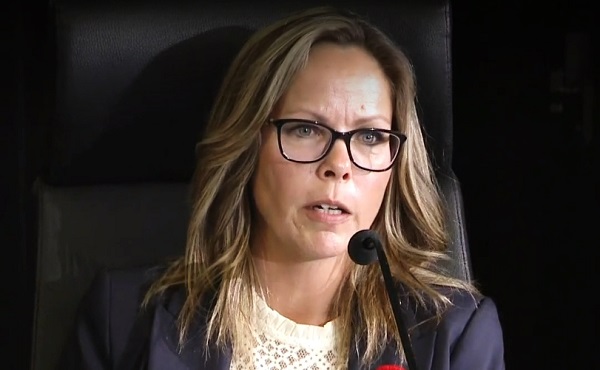COVID-19
Canadian Broadway star & actor Nick Cordero loses leg, fights for life in LA hospital

The corona virus pandemic has been a beast and nightmare for millions of people, family members, health workers and more around the world.
For Hamilton-raised Broadway star Nick Cordero, his wife theatre stage dancer, personal fitness trainer Amanda Kloots and their 10-month-old son, Elvis, this deadly virus has been especially cruel for weeks now.
Cordero has been on life supported ventilation since early April. He has now had his right leg amputated on Saturday night after developing an infection in intensive care at Cedars-Sinai Medical Center in Los Angeles. Cordero has had many complications during his weeks long fight with the coronavirus.
Cordero was being treated with blood thinners to help with clotting and blood circulation in his right leg. His doctors had to stop that part of his treatment because the blood thinner started causing internal bleeding.
“We took him off blood thinners but that again was going to cause some clotting in the right leg, so the right leg will be amputated today,” Amanda Kloots’ Instagram post Saturday afternoon
Cordero has been a very active, healthy actor, performer, father and husband before he was struck down with Covid- 19. He was first admitted with what the doctors thought was pneumonia, he was tested twice for the virus and both were negative. As his condition worsened the doctors ordered a third test and it came back positive for Covid- 19. There is currently no known cure for this pandemic virus that has killed over 166,000 people world-wide.

Nick Cordero with the national tour of Rock of Ages. Photo Courtesy/Production Still/Cordero Family
Aside from being on life support, his doctors have also had him on dialysis treatments to support his kidneys, while also battling other complications for almost 3-weeks now.
Since his positive test, Kloots has not been allowed to visit her now fragile husband in hospital. Being isolated at home she has kept her family, friends and Nick’s fans up-to-date on social media through her Instagram account, www.instagram.com/amandakloots
- “I know Nick is surrounded by angels right now.”
- “I got a phone call from the hospital saying that Nick made it out of surgery alive and he is headed to his room to rest and recover! AMEN!”
- “He is hearing us!!! He is hearing the support, the love and your voices every day. I just know it.”

Nick Cordero in Rock of Ages.
- “I really needed to move today, to scream, to head bang, to spin, to jump, to sing and dance! I was a nervous wreck the whole day as Nick was in surgery just waiting by the phone to hear he got through it. HE DID!”
- “Thank you God for watching over him and for the incredible doctors and nurses @cedarssinai hospital!”
- “Nick and I met while performing in the Broadway show, Bullets Over Broadway. Let me tell you something about the Broadway community: They are thick as thieves. They are relentless. They are believers!! You can’t stop an artist from creating or wanting to help.”
- “We came out to LA so that Nick could perform in Rock Of Ages, a Broadway show that was making its Hollywood Blvd debut. His cast, including this man @frankiejgrande, have embraced us and Nick the whole way through. They are angels that have proven to me that “Don’t Stop Believing”
- Posted Sunday April 19th; Part of our wedding dance ❤️ that our friends @swaywithmeny choreographed for us. I love dancing with you @nickcordero1 and we WILL dance again. Link to video of the wedding dance.

First published on April 18th and updated on April 19th.
COVID-19
Canadian veteran challenges conviction for guarding War Memorial during Freedom Convoy

From LifeSiteNews
When the convoy first came to Ottawa, allegations were floated that the memorial had been desecrated. After learning of this, Evely quickly organized a group of veterans to stand guard around the clock to protect the area.
A Canadian veteran appealed to the Ontario courts after he was convicted for organizing a guard around the National War Memorial during the Freedom Convoy.
In an October press release, the Justice Centre for Constitutional Freedoms (JCCF) announced that an appeal has been filed in the Ontario Court of Appeals on behalf of Master Warrant Officer (Ret’d) Jeffrey Evely over his conviction for mischief and obstructing police while on his way to guard the Ottawa War Memorial during the 2022 Freedom Convoy.
“By locking down large sections of downtown Ottawa, the police were effectively preventing all civilians from accessing public areas and greatly exceeded their powers under the common law,” constitutional lawyer Chris Fleury explained.
“This case raises issues that have implications for protests across the province and the country. We are hopeful that the Ontario Court of Appeal will agree and grant leave to appeal,” he added.
The appeal argues that police overstepped their authority in their response to the 2022 protest of COVID mandates. Police actions at the time included locking down the Ottawa core, establishing checkpoints, and arresting protesters.
In September 2024, Everly was convicted of mischief and obstruction after his involvement in the 2022 Freedom Convoy, which protested COVID mandates by gathering Canadians in front of Parliament in Ottawa.
As LifeSiteNews previously reported, when the convoy first came to Ottawa, allegations were floated that the memorial had been desecrated. After learning of this, Evely quickly organized a group of veterans to stand guard around the clock to protect the area.
However, under former Prime Minister Justin Trudeau’s use of the Emergencies Act, many parts of downtown Ottawa were blocked to the public, and a vigilant police force roamed the streets.
It was during this time that Evely was arrested for entering a closed off section of downtown Ottawa during the early hours of February 19, 2022. He had been on his way to take the 4:25 a.m. shift protecting the Ottawa War Memorial.
As Evely walked to the memorial, he was allegedly told to stop by police. According to the police, Evely “ran for a short distance before being confronted by two additional police officers.”
He was forcibly pushed to the ground, landing face first. The veteran was then arrested and charged with mischief and obstructing police.
At the time, the use of the EA was justified by claims that the protest was “violent,” a claim that has still gone unsubstantiated.
In fact, videos of the protest against COVID regulations and shot mandates show Canadians from across the country gathering outside Parliament engaged in dancing, street hockey, and other family-friendly activities.
Indeed, the only acts of violence caught on video were carried out against the protesters after the Trudeau government directed police to end the protest. One such video showed an elderly women being trampled by a police horse.
While the officers’ actions were originally sanctioned under the EA, Federal Court Justice Richard Mosley ruled that Trudeau was “not justified” in invoking the EA, forcing Crown prosecutors to adopt a different strategy.
Now, Crown prosecutors allege that the common law granted police the authority to stop and detain Evely, regardless of the EA.
However, Evely and his lawyers have challenged this argument under section 9 of the Canadian Charter of Rights and Freedoms, insisting that his “arrest and detention were arbitrary.”
Earlier this month, Freedom Convoy organizers Tamara Lich and Chris Barber were sentenced to 18-month house arrest after a harrowing 25-month trial process. Many have condemned the sentence, warning it amounts to “political persecution” of those who stand up to the Liberal government.
COVID-19
Freedom Convoy leader Tamara Lich says ‘I am not to leave the house’ while serving sentence

From LifeSiteNews
‘I was hoping to be able to drop off and pick up my grandsons from school, but apparently that request will have to go to a judge’
Freedom Convoy leader Tamara Lich detailed her restrictive house arrest conditions, revealing she is “not” able to leave her house or even pick up her grandkids from school without permission from the state.
Lich wrote in a X post on Wednesday that this past Tuesday was her first meeting with her probation officer, whom she described as “fair and efficient,” adding that she was handed the conditions set out by the judge.
“I was hoping to be able to drop off and pick up my grandsons from school, but apparently that request will have to go to a judge under a variation application, so we’ll just leave everything as is for now,” she wrote.
Lich noted that she has another interview with her probation officer next week to “assess the level of risk I pose to re-offend.”
“It sounds like it’ll basically be a questionnaire to assess my mental state and any dangers I may pose to society,” she said.
While it is common for those on house arrest to have to ask for permission to leave their house, sometimes arrangements can be made otherwise.
On October 7, Ontario Court Justice Heather Perkins-McVey sentenced Lich and Chris Barber to 18 months’ house arrest after being convicted earlier in the year convicted of “mischief.”
Lich was given 18 months less time already spent in custody, amounting to 15 1/2 months.
As reported by LifeSiteNews, the Canadian government was hoping to put Lich in jail for no less than seven years and Barber for eight years for their roles in the 2022 protests against COVID mandates.
Interestingly, Perkins-McVey said about Lich and Barber during the sentencing, “They came with the noblest of intent and did not advocate for violence.”
Lich said that her probation officer “informed me of the consequences should I breach these conditions, and I am not to leave the house, even for the approved ‘necessities of life’ without contacting her to let her know where I’ll be and for how long,” she wrote.
“She will then provide a letter stating I have been granted permission to be out in society. I’m to have my papers on my person at all times and ready to produce should I be pulled over or seen by law enforcement out and about.”
Lich said that the probation officer did print a letter “before I left, so I could stop at the optometrist and dentist offices on my way home.”
She said that her official release date is January 21, 2027, which she said amounts to “1,799 days after my initial arrest.”
As reported by LifeSiteNews, Lich, reflecting on her recent house arrest verdict, said she has no “remorse” and will not “apologize” for leading a movement that demanded an end to all COVID mandates.
LifeSiteNews reported that Conservative Party leader Pierre Poilievre offered his thoughts on the sentencing, wishing them a “peaceful” life while stopping short of blasting the sentence as his fellow MPs did.
In early 2022, the Freedom Convoy saw thousands of Canadians from coast to coast come to Ottawa to demand an end to COVID mandates in all forms. Despite the peaceful nature of the protest, Trudeau’s government enacted the never-before-used Emergencies Act (EA) on February 14, 2022.
-

 Business2 days ago
Business2 days agoCanada heading into economic turbulence: The USMCA is finished and Canadian elbows may have started the real fight
-

 Internet2 days ago
Internet2 days agoMusk launches Grokipedia to break Wikipedia’s information monopoly
-

 Business2 days ago
Business2 days agoBill Gates walks away from the climate cult
-

 National1 day ago
National1 day agoCanadian MPs order ethics investigation into Mark Carney’s corporate interests
-

 National1 day ago
National1 day agoCanada’s NDP is now calling women ‘non-males’
-

 Business1 day ago
Business1 day agoFord’s Liquor War Trades Economic Freedom For Political Theatre
-

 Banks1 day ago
Banks1 day agoBank of Canada Cuts Rates to 2.25%, Warns of Structural Economic Damage
-

 Health2 days ago
Health2 days agoLeslyn Lewis urges Canadians to fight WHO pandemic treaty before it’s legally binding








